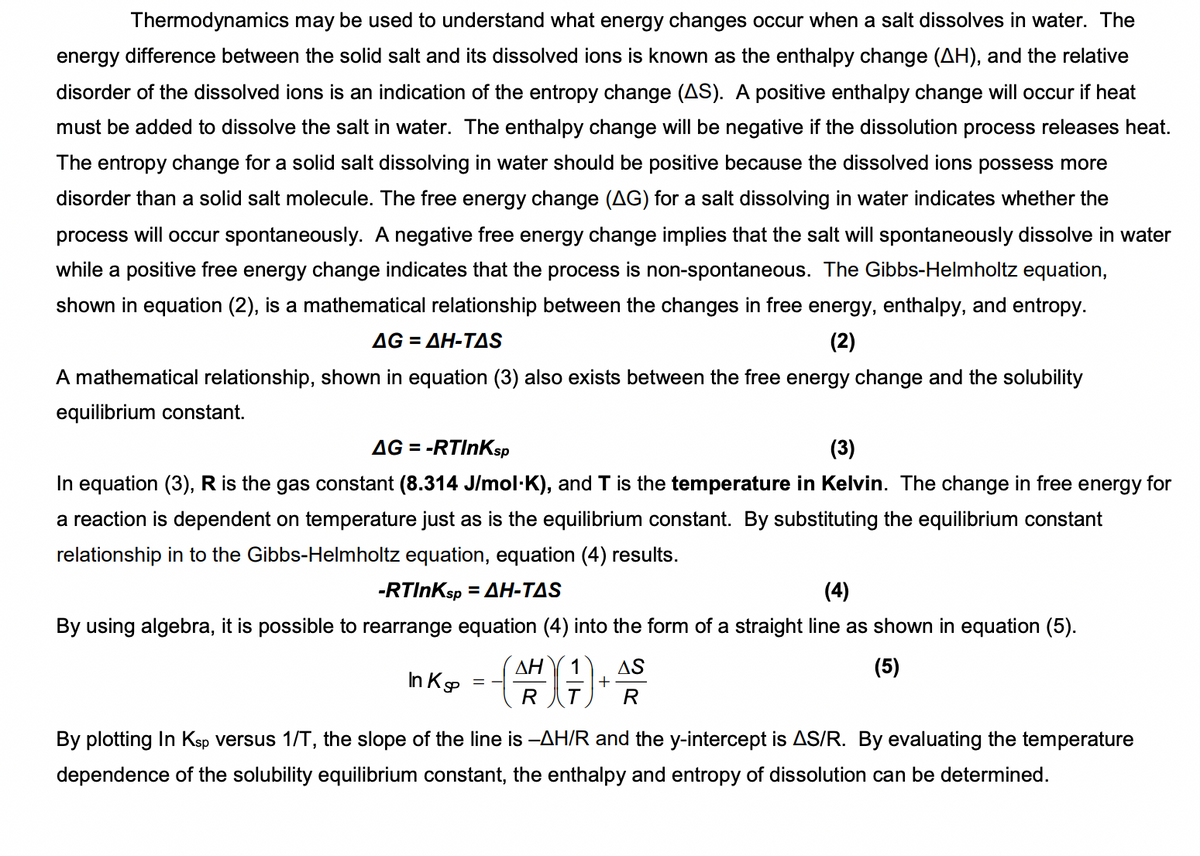A chart is prepared by plotting In Ksp versus 1/T, using data obtained by performing a lab experiment. Refer to the attached photo for reference on how to solve these equations. Particularly #5 should be useful: A linear fit of the data in the chart yields the equation y = (-5.0020x10^3)x+(2.100x10^1) with an R2 value of 0.9922. Determine the enthalpy (deltaH in kJ) associated with dissolving KNO3. Answer in scientific notation with appropriate sigfigs.
A chart is prepared by plotting In Ksp versus 1/T, using data obtained by performing a lab experiment. Refer to the attached photo for reference on how to solve these equations. Particularly #5 should be useful: A linear fit of the data in the chart yields the equation y = (-5.0020x10^3)x+(2.100x10^1) with an R2 value of 0.9922. Determine the enthalpy (deltaH in kJ) associated with dissolving KNO3. Answer in scientific notation with appropriate sigfigs.
General Chemistry - Standalone book (MindTap Course List)
11th Edition
ISBN:9781305580343
Author:Steven D. Gammon, Ebbing, Darrell Ebbing, Steven D., Darrell; Gammon, Darrell Ebbing; Steven D. Gammon, Darrell D.; Gammon, Ebbing; Steven D. Gammon; Darrell
Publisher:Steven D. Gammon, Ebbing, Darrell Ebbing, Steven D., Darrell; Gammon, Darrell Ebbing; Steven D. Gammon, Darrell D.; Gammon, Ebbing; Steven D. Gammon; Darrell
Chapter18: Thermodynamics And Equilibrium
Section: Chapter Questions
Problem 18.122QP: Coal is used as a fuel in some electric-generating plants. Coal is a complex material, but for...
Related questions
Question
A chart is prepared by plotting In Ksp versus 1/T, using data obtained by performing a lab experiment. Refer to the attached photo for reference on how to solve these equations. Particularly #5 should be useful:
A linear fit of the data in the chart yields the equation y = (-5.0020x10^3)x+(2.100x10^1) with an R2 value of 0.9922. Determine the enthalpy (deltaH in kJ) associated with dissolving KNO3.
Answer in scientific notation with appropriate sigfigs.

Transcribed Image Text:Thermodynamics may be used to understand what energy changes occur when a salt dissolves in water. The
energy difference between the solid salt and its dissolved ions is known as the enthalpy change (AH), and the relative
disorder of the dissolved ions is an indication of the entropy change (AS). A positive enthalpy change will occur if heat
must be added to dissolve the salt in water. The enthalpy change will be negative if the dissolution process releases heat.
The entropy change for a solid salt dissolving in water should be positive because the dissolved ions possess more
disorder than a solid salt molecule. The free energy change (AG) for a salt dissolving in water indicates whether the
process will occur spontaneously. A negative free energy change implies that the salt will spontaneously dissolve in water
while a positive free energy change indicates that the process is non-spontaneous. The Gibbs-Helmholtz equation,
shown in equation (2), is a mathematical relationship between the changes in free energy, enthalpy, and entropy.
ΔG -ΔΗ-ΤAS
(2)
A mathematical relationship, shown in equation (3) also exists between the free energy change and the solubility
equilibrium constant.
AG = -RTInKsp
(3)
%3D
In equation (3), R is the gas constant (8.314 J/mol·K), and T is the temperature in Kelvin. The change in free energy for
a reaction is dependent on temperature just as is the equilibrium constant. By substituting the equilibrium constant
relationship in to the Gibbs-Helmholtz equation, equation (4) results.
-RTINKSP
-ΔΗ-ΤAS
(4)
By using algebra, it is possible to rearrange equation (4) into the form of a straight line as shown in equation (5).
(5)
AS
+
R
AH
In Kp
R
By plotting In Ksp versus 1/T, the slope of the line is -AH/R and the y-intercept is AS/R. By evaluating the temperature
dependence of the solubility equilibrium constant, the enthalpy and entropy of dissolution can be determined.
Expert Solution
This question has been solved!
Explore an expertly crafted, step-by-step solution for a thorough understanding of key concepts.
This is a popular solution!
Trending now
This is a popular solution!
Step by step
Solved in 2 steps with 1 images

Knowledge Booster
Learn more about
Need a deep-dive on the concept behind this application? Look no further. Learn more about this topic, chemistry and related others by exploring similar questions and additional content below.Recommended textbooks for you

General Chemistry - Standalone book (MindTap Cour…
Chemistry
ISBN:
9781305580343
Author:
Steven D. Gammon, Ebbing, Darrell Ebbing, Steven D., Darrell; Gammon, Darrell Ebbing; Steven D. Gammon, Darrell D.; Gammon, Ebbing; Steven D. Gammon; Darrell
Publisher:
Cengage Learning

Chemistry: Principles and Reactions
Chemistry
ISBN:
9781305079373
Author:
William L. Masterton, Cecile N. Hurley
Publisher:
Cengage Learning

Chemistry & Chemical Reactivity
Chemistry
ISBN:
9781337399074
Author:
John C. Kotz, Paul M. Treichel, John Townsend, David Treichel
Publisher:
Cengage Learning

General Chemistry - Standalone book (MindTap Cour…
Chemistry
ISBN:
9781305580343
Author:
Steven D. Gammon, Ebbing, Darrell Ebbing, Steven D., Darrell; Gammon, Darrell Ebbing; Steven D. Gammon, Darrell D.; Gammon, Ebbing; Steven D. Gammon; Darrell
Publisher:
Cengage Learning

Chemistry: Principles and Reactions
Chemistry
ISBN:
9781305079373
Author:
William L. Masterton, Cecile N. Hurley
Publisher:
Cengage Learning

Chemistry & Chemical Reactivity
Chemistry
ISBN:
9781337399074
Author:
John C. Kotz, Paul M. Treichel, John Townsend, David Treichel
Publisher:
Cengage Learning

Principles of Modern Chemistry
Chemistry
ISBN:
9781305079113
Author:
David W. Oxtoby, H. Pat Gillis, Laurie J. Butler
Publisher:
Cengage Learning

Chemistry: Principles and Practice
Chemistry
ISBN:
9780534420123
Author:
Daniel L. Reger, Scott R. Goode, David W. Ball, Edward Mercer
Publisher:
Cengage Learning

Chemistry for Engineering Students
Chemistry
ISBN:
9781337398909
Author:
Lawrence S. Brown, Tom Holme
Publisher:
Cengage Learning